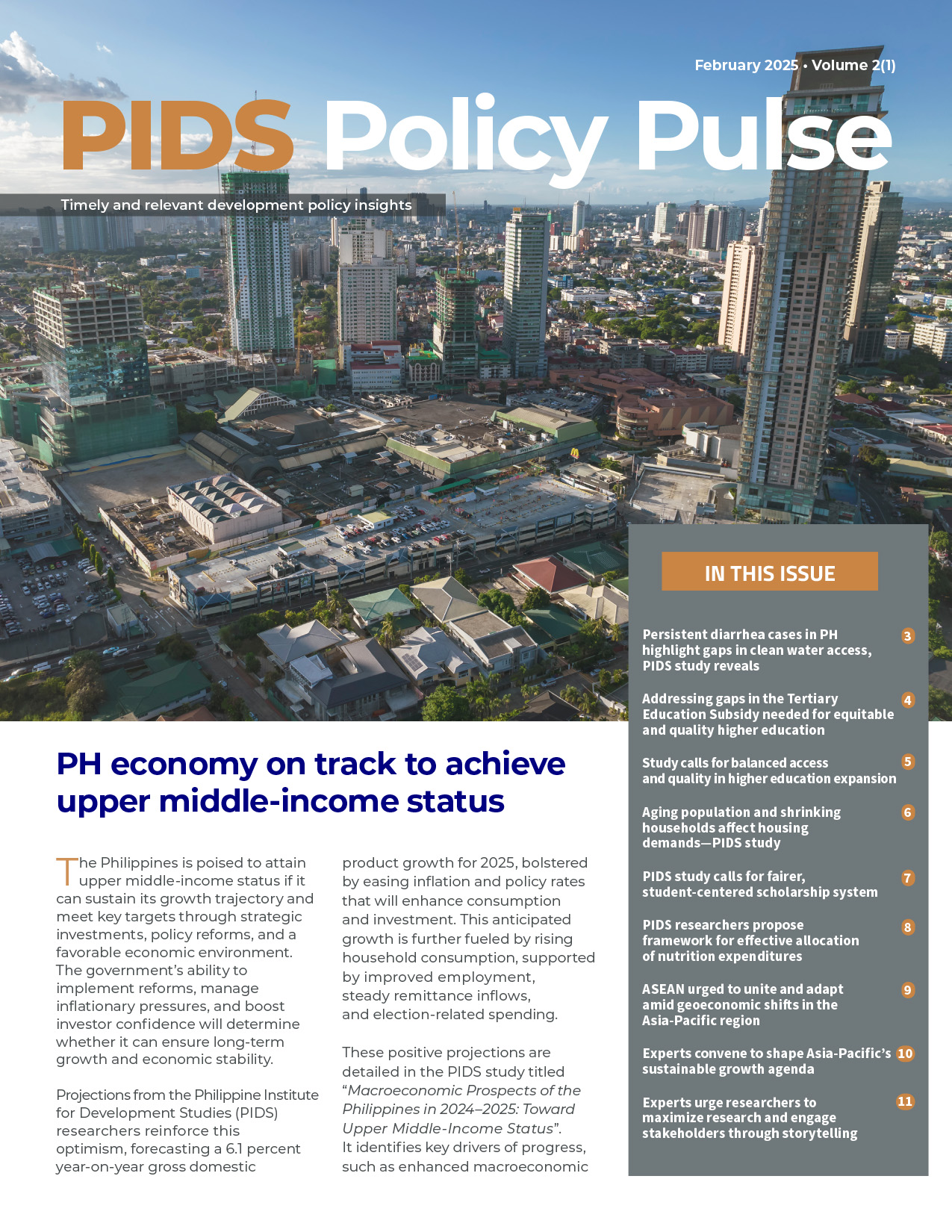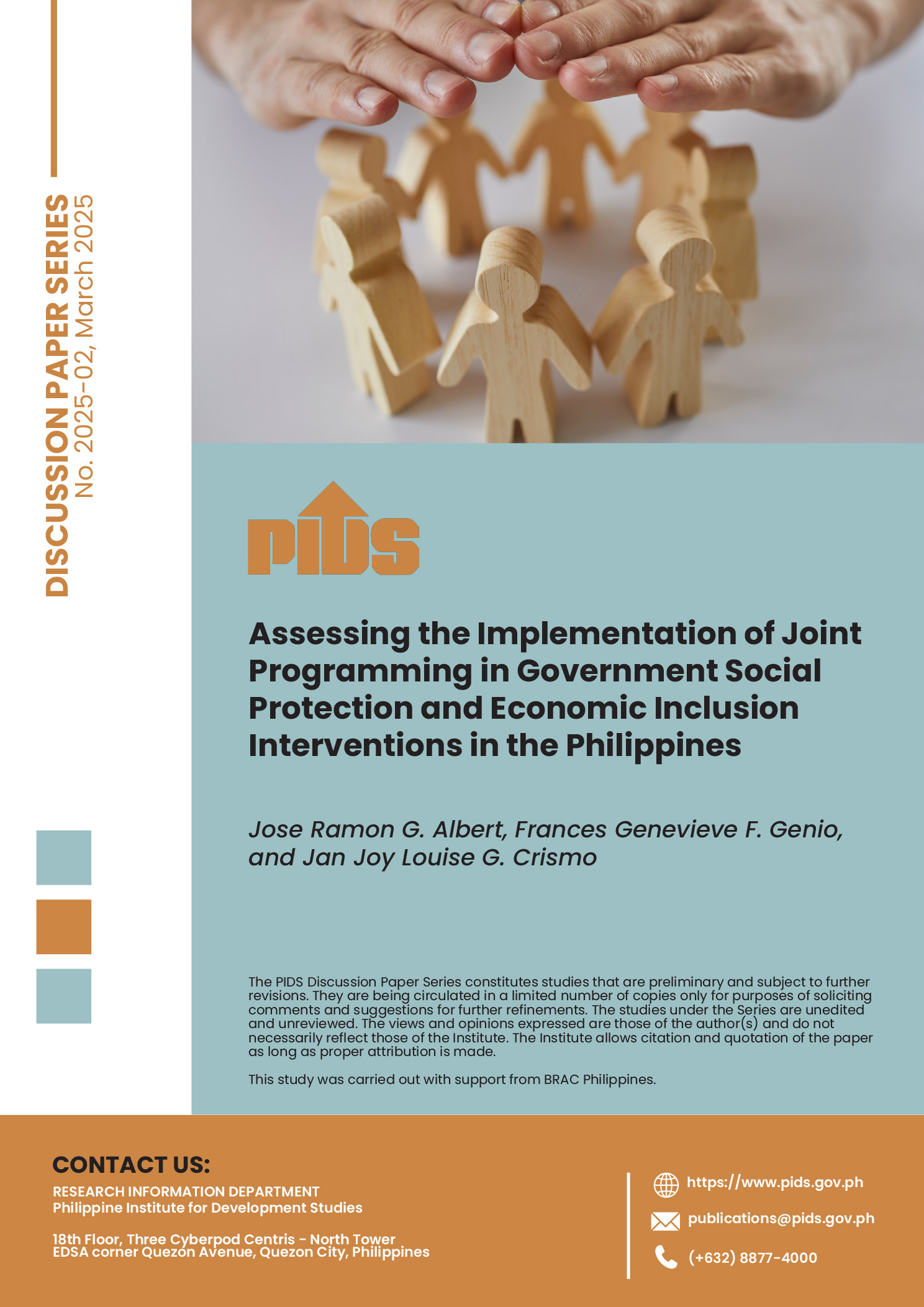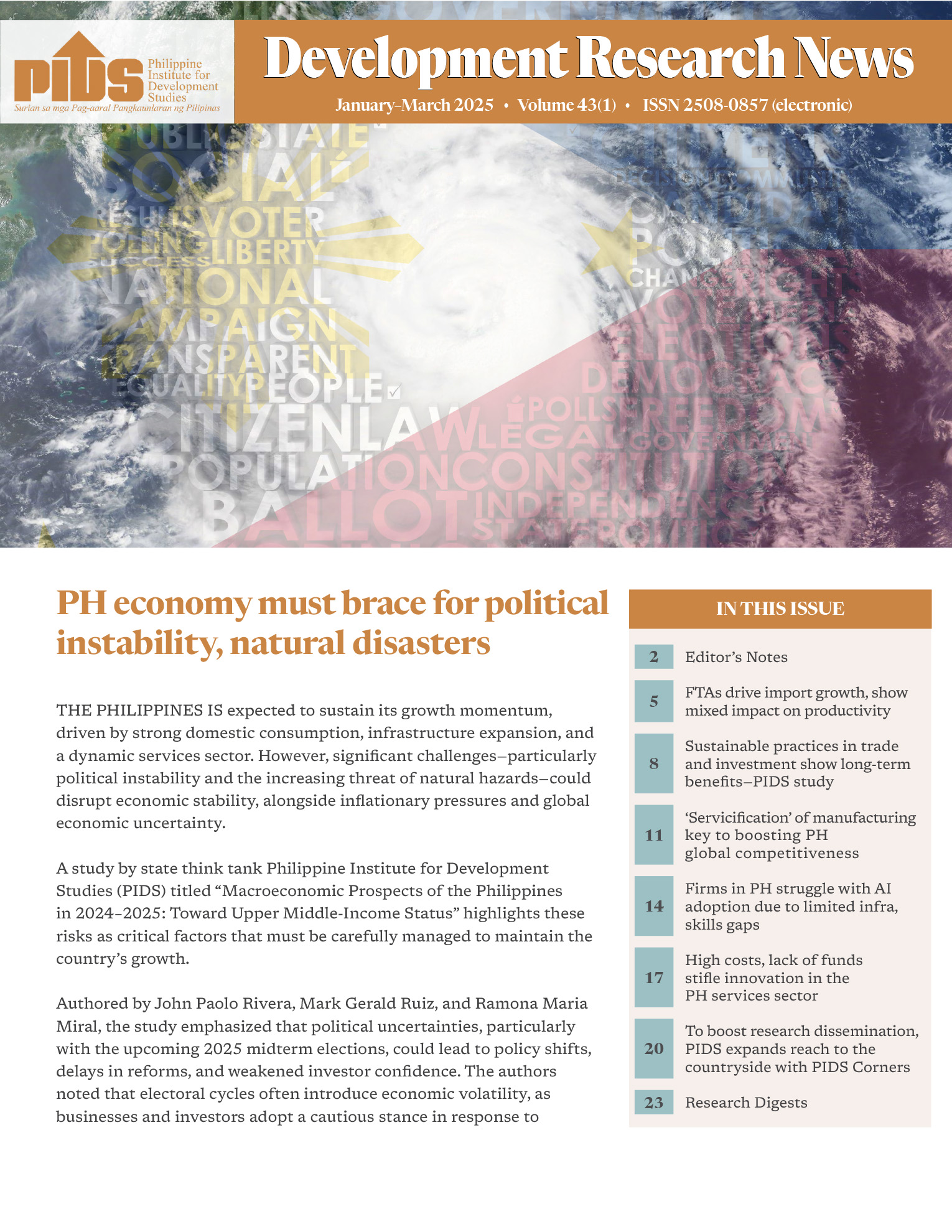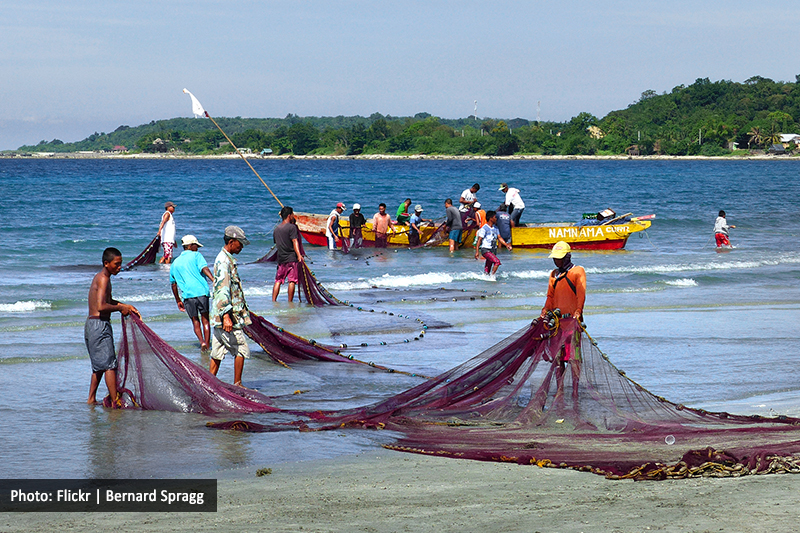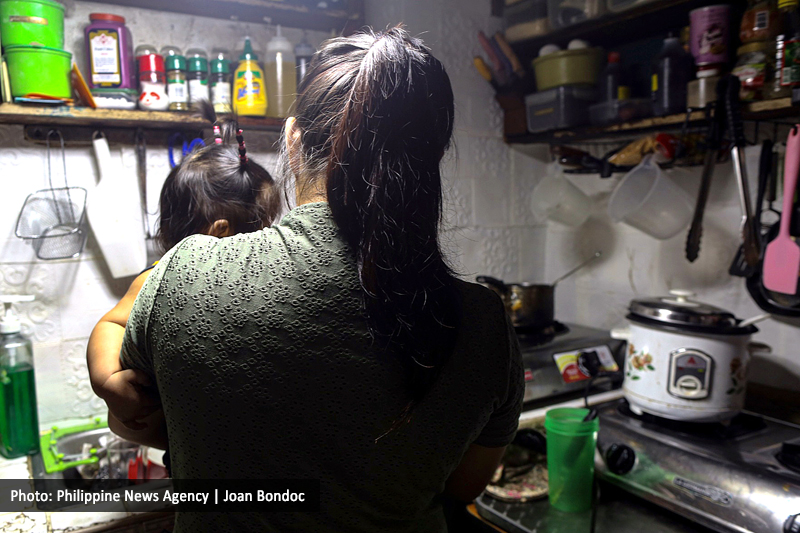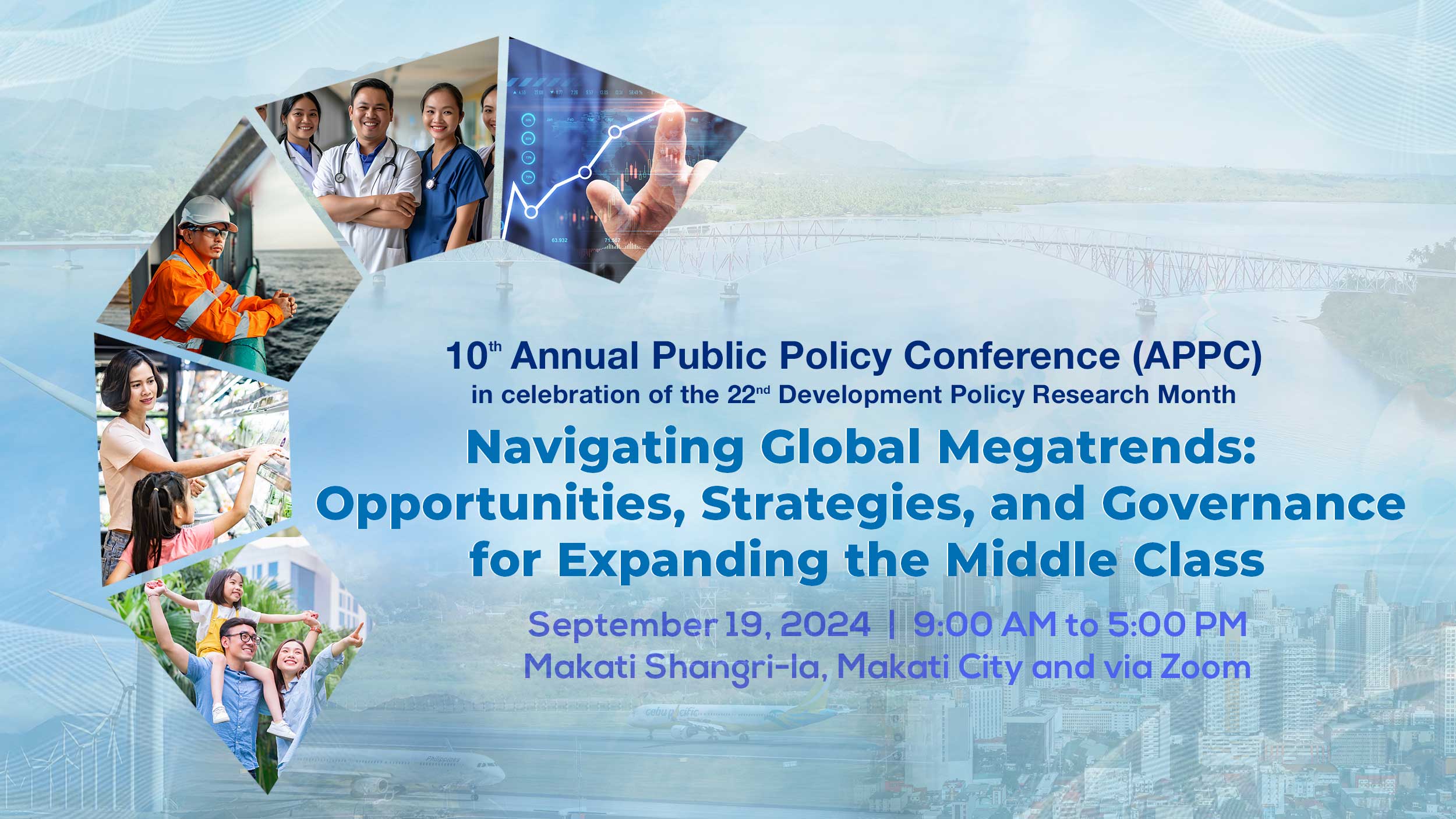In 2012, the income share of the middle class can be estimated at about a third of total household income in the Philippines
When the Philippine Statistics Authority released the Gross Domestic Product (GDP) growth figures of 5.2 percent for the first quarter of the year, many analysts considered this to be lower than their expectations. During all quarters of 2012-2014, GDP growth was 5.5 percent or over.
The first quarter growth of 2015could have been much better had government not underspent. Still, the Q12015 growth is remarkable considering that private sector expenditures and investments continue to be robust.
Why is there so much attention to the GDP?
When a country’s economic production and growth (as measured by the GDP) is healthy, we expect to see low unemployment and increases in incomes as businesses demand more labor to meet the growing economy. An abrupt change in the GDP also has effects on the stock market. A healthy economy which indicates high consumption and production would translate into higher profits for companies, which in turn, would increase stock prices.
As an economy grows, we also expect household living conditions to move in a parallel direction, but prosperity is not felt uniformly. Growth is not necessarily inclusive. Some people are left out of growth processes. Others, especially many of our billionaires led by top three taipans Henry Sy, John Gokonwei, Jr. and Enrique Razon find their wealth growing even faster than the entire economy.
In a previous article, we pointed to the lack of changes in poverty and income inequality, despite the economic growth in the Philippines. The country is not alone in facing this malady. This September, the world is set to define a new set of development goals for 2030 called the Sustainable Development Goals (SDGs), the successor to the Millennium Development Goals (MDGs). While the SDGs are far too many for prioritizing action, they provide a framework for monitoring income inequality and inequities in opportunities, and for promoting social inclusion.
As the world commits to the SDGs, it is important for countries to examine the quality of their economic growth. One way of doing so is to study the middle class, whether this group is increasing, and if so, by how much? In this article, we give some facts about the middle class, and leave more details to a discussion paper we intend to release at the Philippine Institute for Development Studies, the government’s think tank.
Why is the middle class important?
A number of researchers attest to the developmental role of the middle class.
The economic historian David Landes (1998) attributed England’s economic progress from the ascendancy of "the great English middle class” as far back as 18th century. Some economists such as William Easterly (2001) asserts that countries with large number of middle class tend to grow faster, conditioned on ethnic diversity.
In a special chapter of its 2010 Key Indicators for Asia and the Pacific, the Asian Development Bank (2010) stressed the vital role of the middle class in fostering private sector growth in Asia and the Pacific. The ADB showed the phenomenal rise of the middle in developing Asia, but warns that a big chunk of the middle class is in the lower portion of income distribution, and this group may easily fall into poverty, and will deserve policy attention.
Who are considered middle class?
While it may seem as though the middle class is easy to define, there is no internationally accepted definition for it. Even the measurement of poverty is contentious as countries may set national poverty lines either from a relative sense (based on average incomes or consumptions), or from an absolute sense (typically based on determination of the cost of basic food and non-food needs for a minimum welfare standard). For the MDGs, an international poverty line has also been monitored using $1-a-day poverty lines based on purchasing power parity (PPP) 1990 prices, and recently updated to thresholds of $1.25-a-day (2005 PPP). Defining the middle class is even more contentious.
The think tank Pew Research Center defines middle class as adults whose annual household income falls on two-thirds to double of the national median income. Easterly defined the "middle class” as those lying between the 20th and 80thpercentile on the consumption distribution. Birdsall et al. (2000) considered households with income between 75 and 125 percent of the median per capita income comprising the middle class. All these definitions are based on a relative sense of the middle class, where thresholds are based on the income distribution itself.
Others suggest definitions of the middle class in an absolute sense, with reference to (absolute) poverty lines.
Martin Ravallion (2009), who used to head World Bank’s Research Group, defined the median value of poverty lines for 70 national poverty lines as the lower bound ($2 per person per day) and the US poverty line ($13) as the upper bound. The ADB report alluded to earlier defined the middle class as those with per capita daily consumption of $2-$20 in 2005 PPP US dollars.
In the local arena, Virola et al., 2013, used a cluster analysis on the income distribution based on the 2012 Family Income and Expenditure (FIES) conducted by the Philippine Statistics Authority (PSA). They yielded a definition of the middle class in the Philippines as those with per capita incomes ranging from about P64,317 to P787,572 (in 2012). Using this definition, Ronald Mendoza and Enrico Gloria pointed out that the middle class is over-taxed.
Alternative definition
In this article, we adopt an alternative definition of the middle class based on absolute thresholds, mirroring the ADB definition, but using some multiples of the official poverty lines.
We define the middle class as those with incomes between four to ten times the poverty line (which, on average, is 6,312 pesos to 15,779 pesos per person in 2012 prices).
For a household of five persons (which is the average family size in the country), the household is thus considered middle class if its total monthly family income ranges around 30 to 80 thousand pesos. The thresholds we use are somewhat arbitrary, but they serve to examine income distribution. For purposes of comparing the middle class with other segments of the income distribution, we decompose the income distribution into seven income groups:
a) poor: those who earn below the official poverty thresholds (averaging P1,578 per person per month)
b) lower income (but not poor): those with incomes between the poverty line and twice the poverty line
c) lower middle income: those with incomes between twice the poverty line and 4 times the poverty line
d) middle income: those with incomes between 4 times and 10 times the poverty line
e) upper middle income: those with incomes between 10 to 15 times the poverty line
f) upper income group (but not rich): those with incomes between 15 to 20 times the poverty line
g) rich: those with incomes greater or equal to 20 the poverty line.
How big is the middle class?
Using data sourced from the 2012 FIES, we estimate that in 2012, the middle class comprised about 3.6 million households. This magnitude constitutes about 3 out of every 20 households (see Figure 1).
In 2012, the income share of the middle class can be estimated at about a third (32.2 percent) of total household income in the country.
Figure 1. Distribution of Households and Shares of Total Household Income by Income Groups, 2012
In constrast, the poor, which comprised about 4.2 million households (19.1 percent of total number of households), had about one twentieth (5.6 percent) of total household income in the country.
On the other end of the spectrum, the rich, which comprised about 156 thousand households (0.7 percent of total households), had even more than the income share of the poor (7.1 percent of total household income). The low income class, the lower middle class and the poor have bigger absolute sizes than the middle class.
The low income class, which is easily vulnerable to falling into poverty in the wake of effects of natural disasters and other income shocks, is about a third of total households.
Examining the 2006 and 2009 FIES, we find that the relative size of the middle class to all households slightly declined in 2009 to 15.8 percent (from 16.2 percent in 2006), and increased to 16.7 percent as of 2012. We find marginal changes in the relative sizes of other income groups across the period 2006, 2009 and 2012.
If we were to aggregate the middle class with the lower middle and upper middle classes, this combined group would be about 9 of 20 families (45.1 percent in 2006, 44.6 percent in 2009, and 45.8 percent in 2012). The total share of their incomes of these three income groups is about two thirds of the country’s household income (65.1 percent in 2006, 64.7 percent in 2009, and 65.6 percent in 2012).
While the changes in the middle class, just like the minute changes in poverty incidence (i.e. the proportion of families that are poor) and the sizes of the other income groups, are not statistically significant, it is noteworthy that the changes in the size of the middle class are accompanied by changes (in the same directions) of the income share of the middle class.
All income groups, on average, earned higher nominal incomes from 2006 to 2009, with the middle class having a rise in nominal incomes by 26 percent (when inflation rose by 16 percent for the period). The increase in incomes across groups slowed down from 2009 to 2012, with the highest income group even garnering a lower average income in 2012 than in 2009.
However, the latter result might be taken with a grain of salt since households of Henry Sy, John Gokongwei Jr. and Enrique Razon are likely not going to participate in the FIES if these households were selected for interview. After all, average interview time for the FIES is five hours, and the PSA even conducts its FIES survey operations twice: in July of the reference year to obtain first semester data, and in January of the succeeding year to get the second semester data.
Table 1. Average Per Capita Income by Income Group, 2006-2012
Income Group Income
2006 2009 2012
Poor 9,528 12,229 13,707
Lower Income (but not Rich) 19,754 24,842 27,642
Lower Middle 39,597 49,183 54,410
Middle Class 83,989 104,112 115,866
Upper Middle 171,669 212,670 236,173
Upper Income (but not rich) 244,504 307,886 332,932
Rich 455,657 658,427 607,958
Source of basic data: Family Income and Expenditure Survey (2006-2012), Philippine Statistics Authority
What should be Done about the middle class?
Across countries where poverty has reduced considerably, especially in China, the middle class has grown rapidly in its share (of total national income), in absolute size, and in purchasing power.
In the Philippines, much attention has been on measuring and monitoring poverty, but poverty reduction has been practically unchanged.
The middle class also deserve some policy attention. If the middle class is to become much more prominent and a stable force for sustaining the growth of the Philippine economy, which of late, has been rather robust, the government will require interventions to further expand the middle class (by even greater spending in the social sector), as well as investments to boost incomes of those already in the middle class (and to prevent them for falling into poverty in the face of income shocks).
There will likely be unintended consequences to expanding the middle class and boosting the incomes of those in the middle class, but these challenges will ultimately provide opportunities for a more inclusive development and shared prosperity in society. — Rappler.com
Dr. Jose Ramon "Toots" Albert is a professional statistician. He is a Senior Research Fellow of the government’s think tank Philippine Institute for Development Studies(PIDS), and the president of the country’s professional society of data producers, users and analysts, the Philippine Statistical Association, Inc. for 2014-2015.
Raymond E. Gaspar is a Research Specialist at Philippine Institute for Development Studies (PIDS) and is currently a Masters in Development Economics student at the UP School of Economics.
Martin Joseph M. Raymundo (not in photo) is a Research Analyst at the Philippine Institute for Development Studies (PIDS).
How big is the middle class? Is it benefiting from economic growth?

